Why Proper Downspout Placement Matters for Your Home's Drainage
- Gutter Genius

- Nov 22, 2024
- 3 min read
Downspouts are an integral part of a home’s drainage system, working hand-in-hand with gutters to protect your property from water damage. Their role goes beyond aesthetics, as their placement directly affects how effectively water is redirected away from your home. Poorly positioned or undersized downspouts can lead to costly problems like foundation issues, landscape erosion, and basement flooding. Here’s a deeper dive into why downspout placement is crucial and how you can optimize your home’s drainage system.

The Importance of Downspout Placement
The primary function of downspouts is to transport water away from the roofline and direct it to a safe distance from your home. However, where the water goes after leaving the downspout makes all the difference. Improper placement can lead to significant issues such as:
Foundation Damage: When water pools near the foundation, it increases hydrostatic pressure, potentially leading to cracks, leaks, and weakening of the structure over time.

Basement Flooding: Inefficient drainage can cause water to seep into basements or crawl spaces, creating the perfect environment for mold and mildew.

Erosion and Landscaping Damage: Excess water flow can wash away soil, damage plants, and ruin hardscaping features like patios and walkways.

Best Practices for Downspout Placement
To ensure your downspouts perform their job effectively, follow these guidelines:
Proper Distance from the Foundation: Downspouts should discharge water at least 4-6 feet away from the home. This can be achieved using extensions or splash blocks to prevent pooling.

Angled Away from Structures: Ensure downspouts direct water away from driveways, walkways, or nearby structures to avoid surface cracking or ice buildup during colder months.

Connection to Drainage Systems: For properties with extensive landscaping or poor natural drainage, connect downspouts to underground pipes or a French drain system to channel water farther away.

Adequate Capacity: Make sure your downspouts can handle the volume of water your gutters collect, especially during heavy rains. If not, consider adding additional downspouts to prevent overflow.

Warning Signs of Improper Downspout Placement
Not all problems are obvious at first glance. Here are some signs that your downspout placement might need attention:
Puddles forming near the foundation after rain.
Water stains or moisture on basement walls.
Cracking or shifting in your foundation.
Erosion or bare patches in landscaping.
Addressing these issues early can prevent larger, more costly repairs in the future.

Innovative Solutions for Better Water Management
At Gutter Genius, we specialize in providing modern, efficient solutions for home drainage. We offer premium products like downspout extensions, splash guards, and complete gutter systems that are custom-designed to suit your home’s unique needs. Whether you’re looking to upgrade an outdated system or address existing issues, we have the tools and expertise to help.

What to Do if You Already Have Drainage Problems
If water pooling or damage has already occurred, don’t delay in taking action. Contacting a professional is essential to assess the extent of the problem. In some cases, it may involve redirecting existing downspouts, adding additional drainage features, or repairing structural damage caused by water exposure. Gutter Genius can provide a comprehensive inspection and recommend tailored solutions to restore and protect your home.
Call the Experts
Protecting your home starts with a reliable drainage system. At Gutter Genius, we take pride in helping homeowners optimize their gutter and downspout systems for maximum efficiency. Contact us today for an inspection and let us help you safeguard your home from water damage!





Comments